Joachim Denzler
Computer Vision Group, Friedrich Schiller University of Jena, Michael Stifel Center, Jena
Saccadic Vision for Fine-Grained Visual Classification
Sep 19, 2025Abstract:Fine-grained visual classification (FGVC) requires distinguishing between visually similar categories through subtle, localized features - a task that remains challenging due to high intra-class variability and limited inter-class differences. Existing part-based methods often rely on complex localization networks that learn mappings from pixel to sample space, requiring a deep understanding of image content while limiting feature utility for downstream tasks. In addition, sampled points frequently suffer from high spatial redundancy, making it difficult to quantify the optimal number of required parts. Inspired by human saccadic vision, we propose a two-stage process that first extracts peripheral features (coarse view) and generates a sample map, from which fixation patches are sampled and encoded in parallel using a weight-shared encoder. We employ contextualized selective attention to weigh the impact of each fixation patch before fusing peripheral and focus representations. To prevent spatial collapse - a common issue in part-based methods - we utilize non-maximum suppression during fixation sampling to eliminate redundancy. Comprehensive evaluation on standard FGVC benchmarks (CUB-200-2011, NABirds, Food-101 and Stanford-Dogs) and challenging insect datasets (EU-Moths, Ecuador-Moths and AMI-Moths) demonstrates that our method achieves comparable performance to state-of-the-art approaches while consistently outperforming our baseline encoder.
Distance-informed Neural Processes
Aug 26, 2025Abstract:We propose the Distance-informed Neural Process (DNP), a novel variant of Neural Processes that improves uncertainty estimation by combining global and distance-aware local latent structures. Standard Neural Processes (NPs) often rely on a global latent variable and struggle with uncertainty calibration and capturing local data dependencies. DNP addresses these limitations by introducing a global latent variable to model task-level variations and a local latent variable to capture input similarity within a distance-preserving latent space. This is achieved through bi-Lipschitz regularization, which bounds distortions in input relationships and encourages the preservation of relative distances in the latent space. This modeling approach allows DNP to produce better-calibrated uncertainty estimates and more effectively distinguish in- from out-of-distribution data. Empirical results demonstrate that DNP achieves strong predictive performance and improved uncertainty calibration across regression and classification tasks.
FastCAV: Efficient Computation of Concept Activation Vectors for Explaining Deep Neural Networks
May 23, 2025Abstract:Concepts such as objects, patterns, and shapes are how humans understand the world. Building on this intuition, concept-based explainability methods aim to study representations learned by deep neural networks in relation to human-understandable concepts. Here, Concept Activation Vectors (CAVs) are an important tool and can identify whether a model learned a concept or not. However, the computational cost and time requirements of existing CAV computation pose a significant challenge, particularly in large-scale, high-dimensional architectures. To address this limitation, we introduce FastCAV, a novel approach that accelerates the extraction of CAVs by up to 63.6x (on average 46.4x). We provide a theoretical foundation for our approach and give concrete assumptions under which it is equivalent to established SVM-based methods. Our empirical results demonstrate that CAVs calculated with FastCAV maintain similar performance while being more efficient and stable. In downstream applications, i.e., concept-based explanation methods, we show that FastCAV can act as a replacement leading to equivalent insights. Hence, our approach enables previously infeasible investigations of deep models, which we demonstrate by tracking the evolution of concepts during model training.
Probabilistic Embeddings for Frozen Vision-Language Models: Uncertainty Quantification with Gaussian Process Latent Variable Models
May 08, 2025Abstract:Vision-Language Models (VLMs) learn joint representations by mapping images and text into a shared latent space. However, recent research highlights that deterministic embeddings from standard VLMs often struggle to capture the uncertainties arising from the ambiguities in visual and textual descriptions and the multiple possible correspondences between images and texts. Existing approaches tackle this by learning probabilistic embeddings during VLM training, which demands large datasets and does not leverage the powerful representations already learned by large-scale VLMs like CLIP. In this paper, we propose GroVE, a post-hoc approach to obtaining probabilistic embeddings from frozen VLMs. GroVE builds on Gaussian Process Latent Variable Model (GPLVM) to learn a shared low-dimensional latent space where image and text inputs are mapped to a unified representation, optimized through single-modal embedding reconstruction and cross-modal alignment objectives. Once trained, the Gaussian Process model generates uncertainty-aware probabilistic embeddings. Evaluation shows that GroVE achieves state-of-the-art uncertainty calibration across multiple downstream tasks, including cross-modal retrieval, visual question answering, and active learning.
F-INR: Functional Tensor Decomposition for Implicit Neural Representations
Mar 27, 2025Abstract:Implicit Neural Representation (INR) has emerged as a powerful tool for encoding discrete signals into continuous, differentiable functions using neural networks. However, these models often have an unfortunate reliance on monolithic architectures to represent high-dimensional data, leading to prohibitive computational costs as dimensionality grows. We propose F-INR, a framework that reformulates INR learning through functional tensor decomposition, breaking down high-dimensional tasks into lightweight, axis-specific sub-networks. Each sub-network learns a low-dimensional data component (e.g., spatial or temporal). Then, we combine these components via tensor operations, reducing forward pass complexity while improving accuracy through specialized learning. F-INR is modular and, therefore, architecture-agnostic, compatible with MLPs, SIREN, WIRE, or other state-of-the-art INR architecture. It is also decomposition-agnostic, supporting CP, TT, and Tucker modes with user-defined rank for speed-accuracy control. In our experiments, F-INR trains $100\times$ faster than existing approaches on video tasks while achieving higher fidelity (+3.4 dB PSNR). Similar gains hold for image compression, physics simulations, and 3D geometry reconstruction. Through this, F-INR offers a new scalable, flexible solution for high-dimensional signal modeling.
Gradient Extrapolation for Debiased Representation Learning
Mar 17, 2025Abstract:Machine learning classification models trained with empirical risk minimization (ERM) often inadvertently rely on spurious correlations. When absent in the test data, these unintended associations between non-target attributes and target labels lead to poor generalization. This paper addresses this problem from a model optimization perspective and proposes a novel method, Gradient Extrapolation for Debiased Representation Learning (GERNE), designed to learn debiased representations in both known and unknown attribute training cases. GERNE uses two distinct batches with different amounts of spurious correlations to define the target gradient as the linear extrapolation of two gradients computed from each batch's loss. It is demonstrated that the extrapolated gradient, if directed toward the gradient of the batch with fewer amount of spurious correlation, can guide the training process toward learning a debiased model. GERNE can serve as a general framework for debiasing with methods, such as ERM, reweighting, and resampling, being shown as special cases. The theoretical upper and lower bounds of the extrapolation factor are derived to ensure convergence. By adjusting this factor, GERNE can be adapted to maximize the Group-Balanced Accuracy (GBA) or the Worst-Group Accuracy. The proposed approach is validated on five vision and one NLP benchmarks, demonstrating competitive and often superior performance compared to state-of-the-art baseline methods.
Electromyography-Informed Facial Expression Reconstruction for Physiological-Based Synthesis and Analysis
Mar 12, 2025
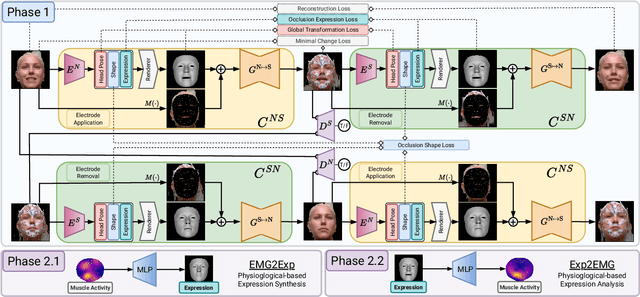

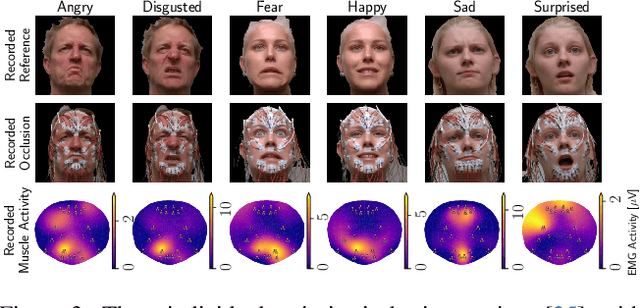
Abstract:The relationship between muscle activity and resulting facial expressions is crucial for various fields, including psychology, medicine, and entertainment. The synchronous recording of facial mimicry and muscular activity via surface electromyography (sEMG) provides a unique window into these complex dynamics. Unfortunately, existing methods for facial analysis cannot handle electrode occlusion, rendering them ineffective. Even with occlusion-free reference images of the same person, variations in expression intensity and execution are unmatchable. Our electromyography-informed facial expression reconstruction (EIFER) approach is a novel method to restore faces under sEMG occlusion faithfully in an adversarial manner. We decouple facial geometry and visual appearance (e.g., skin texture, lighting, electrodes) by combining a 3D Morphable Model (3DMM) with neural unpaired image-to-image translation via reference recordings. Then, EIFER learns a bidirectional mapping between 3DMM expression parameters and muscle activity, establishing correspondence between the two domains. We validate the effectiveness of our approach through experiments on a dataset of synchronized sEMG recordings and facial mimicry, demonstrating faithful geometry and appearance reconstruction. Further, we synthesize expressions based on muscle activity and how observed expressions can predict dynamic muscle activity. Consequently, EIFER introduces a new paradigm for facial electromyography, which could be extended to other forms of multi-modal face recordings.
Towards Locally Explaining Prediction Behavior via Gradual Interventions and Measuring Property Gradients
Mar 07, 2025



Abstract:Deep learning models achieve high predictive performance but lack intrinsic interpretability, hindering our understanding of the learned prediction behavior. Existing local explainability methods focus on associations, neglecting the causal drivers of model predictions. Other approaches adopt a causal perspective but primarily provide more general global explanations. However, for specific inputs, it's unclear whether globally identified factors apply locally. To address this limitation, we introduce a novel framework for local interventional explanations by leveraging recent advances in image-to-image editing models. Our approach performs gradual interventions on semantic properties to quantify the corresponding impact on a model's predictions using a novel score, the expected property gradient magnitude. We demonstrate the effectiveness of our approach through an extensive empirical evaluation on a wide range of architectures and tasks. First, we validate it in a synthetic scenario and demonstrate its ability to locally identify biases. Afterward, we apply our approach to analyze network training dynamics, investigate medical skin lesion classifiers, and study a pre-trained CLIP model with real-life interventional data. Our results highlight the potential of interventional explanations on the property level to reveal new insights into the behavior of deep models.
Anomalous Agreement: How to find the Ideal Number of Anomaly Classes in Correlated, Multivariate Time Series Data
Jan 13, 2025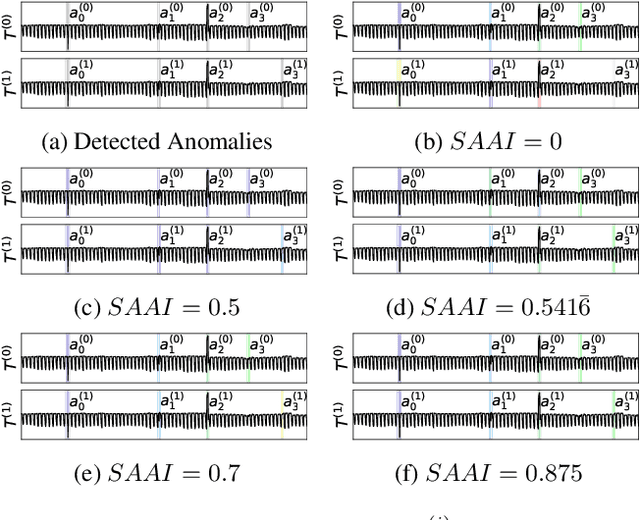
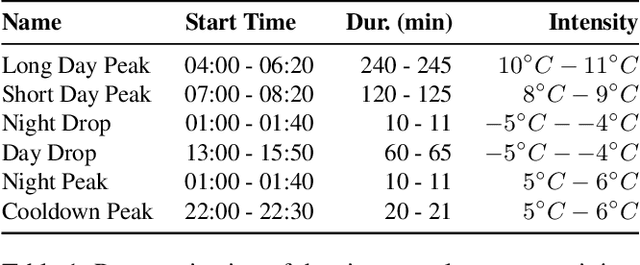
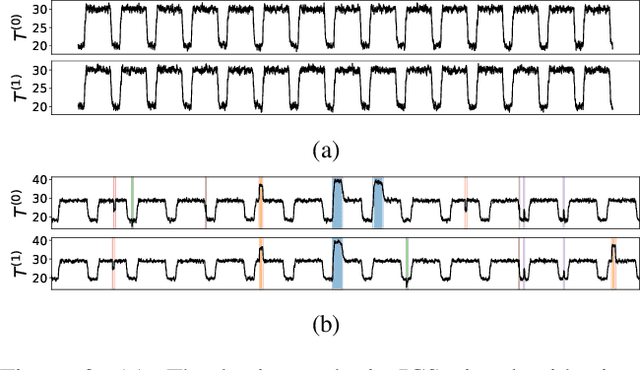

Abstract:Detecting and classifying abnormal system states is critical for condition monitoring, but supervised methods often fall short due to the rarity of anomalies and the lack of labeled data. Therefore, clustering is often used to group similar abnormal behavior. However, evaluating cluster quality without ground truth is challenging, as existing measures such as the Silhouette Score (SSC) only evaluate the cohesion and separation of clusters and ignore possible prior knowledge about the data. To address this challenge, we introduce the Synchronized Anomaly Agreement Index (SAAI), which exploits the synchronicity of anomalies across multivariate time series to assess cluster quality. We demonstrate the effectiveness of SAAI by showing that maximizing SAAI improves accuracy on the task of finding the true number of anomaly classes K in correlated time series by 0.23 compared to SSC and by 0.32 compared to X-Means. We also show that clusters obtained by maximizing SAAI are easier to interpret compared to SSC.
KAN See Your Face
Nov 27, 2024



Abstract:With the advancement of face reconstruction (FR) systems, privacy-preserving face recognition (PPFR) has gained popularity for its secure face recognition, enhanced facial privacy protection, and robustness to various attacks. Besides, specific models and algorithms are proposed for face embedding protection by mapping embeddings to a secure space. However, there is a lack of studies on investigating and evaluating the possibility of extracting face images from embeddings of those systems, especially for PPFR. In this work, we introduce the first approach to exploit Kolmogorov-Arnold Network (KAN) for conducting embedding-to-face attacks against state-of-the-art (SOTA) FR and PPFR systems. Face embedding mapping (FEM) models are proposed to learn the distribution mapping relation between the embeddings from the initial domain and target domain. In comparison with Multi-Layer Perceptrons (MLP), we provide two variants, FEM-KAN and FEM-MLP, for efficient non-linear embedding-to-embedding mapping in order to reconstruct realistic face images from the corresponding face embedding. To verify our methods, we conduct extensive experiments with various PPFR and FR models. We also measure reconstructed face images with different metrics to evaluate the image quality. Through comprehensive experiments, we demonstrate the effectiveness of FEMs in accurate embedding mapping and face reconstruction.
 Add to Chrome
Add to Chrome Add to Firefox
Add to Firefox Add to Edge
Add to Edge